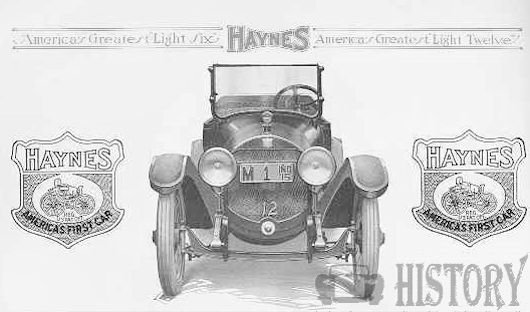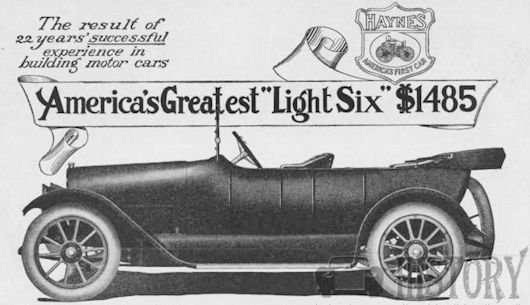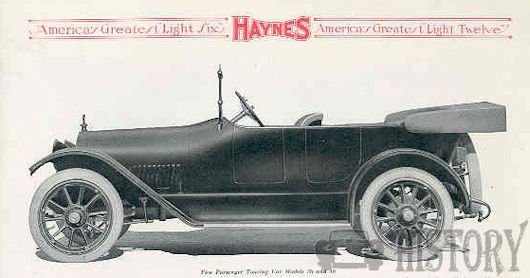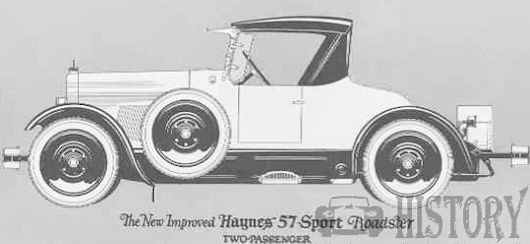Haynes Automobile Company History

The Haynes Automobile Company was a United States automobile manufacturing company which produced automobiles in Kokomo, Indiana, from 1905 to 1924. first as the Haynes-Apperson Company.
History
The company was formerly known as the Haynes-Apperson company which produced automobiles under that name from 1896-1905. Co-founder Elwood Haynes changed the name of the company after fellow co-founders Elmer and Edgar Apperson left to form the Apperson Brothers Automobile Company in 1901. The company was declared bankrupt in 1924 and went out of business in 1925.
Haynes and the Appersons formed a partnership known as Haynes & Apperson, renamed the Haynes-Apperson Company in 1896, and finally incorporated as the Haynes Apperson Automobile Company in 1898.
Elwood Haynes was born on October 14, 1857, at Portland, Indiana. Here his interest and aptitude in science became apparent at an early age.In 1886 to organize a company to supply natural gas to that community. In 1890 he moved to Greentown,to become superintendent for the Indiana Natural Gas and Oil Company. In the fall of 1893 the design of his first automobile was ready. Drawings and engineering info were delivered to the Riverside Machine Works in Kokomo, a machine shop operated by the Apperson
brothers, Elmer and Edgar. Elwood Haynes first Haynes car was designed during 1892 and 1893. The first Haynes car was successfully driven in 1894. The engine was a one horsepower, two-cycle Sintz marine engine.Some modifications were made to this engine, among them a cast aluminum crankcase made at the Ford and Donelly Foundry. The muffler and carburetor were made by George Kingston,All the rest of the car was made to Haynes' specifications in the Riverside Machine Works at Kokomo, operated by Elmer and Edgar Apperson.This first Haynes was completed in 1894,and on July 4th of that year Other experimental cars were made, each an improvement of the previous one. Production of a more standardized models begun around 1895. Late in 1901 Elmer and Edgar Apperson left the company to establish their own business. This was the Apperson Brothers Automobile Company.

Haynes Tonneau from 1905
The name of the original Haynes-Apperson Automobile Company remained unchanged until September of 1905 when the company was reorganized as the Haynes Automobile Company. Four-cylinder engines were used in Haynes cars of 1905 and later, replacing the earlier two cylinder models. New models were called Haynes cars, the Haynes vehicles were of a more conservative design. But Some of the early models had a few unconventional features. Before 1905 all Haynes-Apperson cars were chain driven and used an unusual type of constant-mesh transmission in which gears for the three forward speeds and reverse were fitted to the driving shaft by leather faced, contracting band clutches. This system provided a noiseless shifting,but expensive to produce.but it was not used on any later models. standard bevel gears and sliding gear transmissions were used on all 1906 and later models.
The first larger six cylinder models appeared in 1913 and a large 12-cylinder model was added in 1917. and built to 1922. The depression of the 1920s dealt a fatal blow to many established automobile manufacturing companies, and Haynes was among them Haynes automobiles were in continuous production until the latter part of 1924.The Haynes Automobile company was then declared bankrupt in 1924.

New for 1914, Haynes started offering their 55 hp "Light Six" at $1485, ads boasted it was "The result of 22 years successful experience in building motor cars." Haynes also proclaimed it "Americas greatest light six", that it "will travel 22 to 25 miles on one gallon of gas" and "has more than 1 horsepower to every 55 pounds of weight."

For 1916, Haynes introduced the "Light Twelve", and refined "Light Six" new series, Models 36 and 37.
In 1923, just before going out of business, Haynes introduced the 57 and 77, with a 121-inch (3073 mm) wheelbase, in five-seat four-door sedan, three-seat coupelet, and two-seat roadster, advertised as complete with front and rear bumpers, six disc (as opposed to wire) wheels, wind wings, sun visors, "artistically fashioned individual steps" (for the running boards), and "individual fenders".



